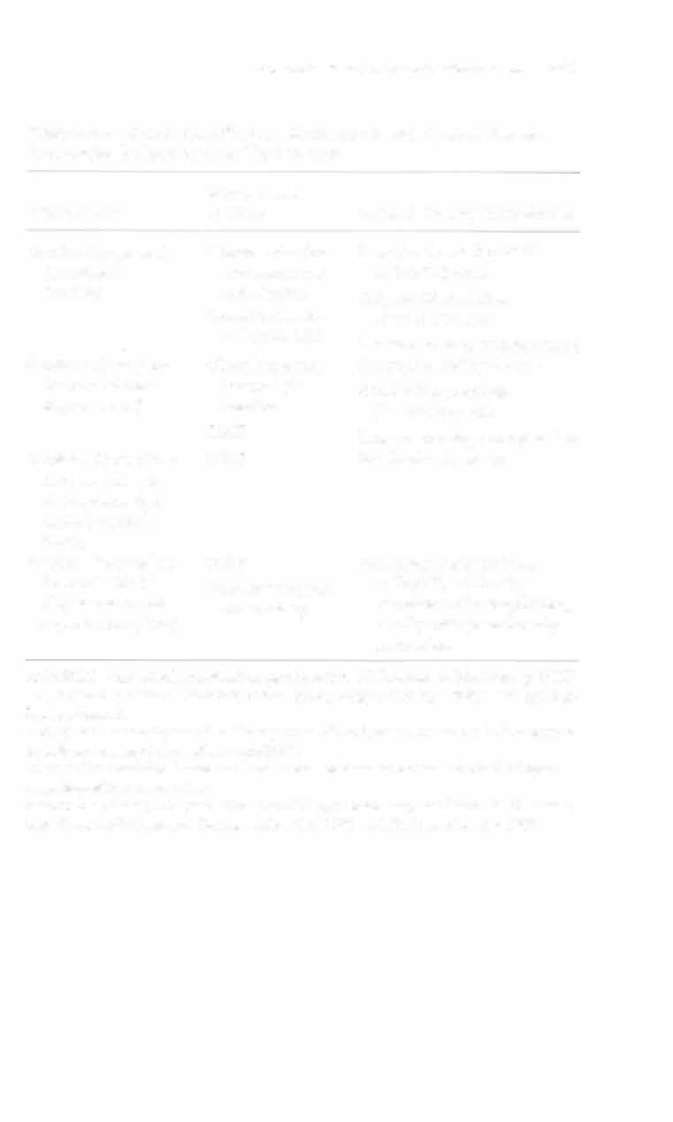i bc27f85be50b71b1 (72 page)
Read i bc27f85be50b71b1 Online
Authors: Unknown

Table 3-A.1. Young Classification, Management, and Physical Therapy Intervention for Pelvic Ring Fractures
N
'"
00
Fracture Type
Management Options
Physical Therapy Interventioll
§
APC, type I�isruption of the pubic
Symptomatic pain managemenc
Functional mobility PWB or WBAT as
symphysis with <2.5 em of diastasis;
tolerated
�
j:;
no significant posterior pelvic injury
Hip and disca) joint NAAROM
:r
>
APC, type ll�isruption of the pubic
External fixation
Functional mobility NWB, -(DWB, or
z
"
symphysis of >2.5 cm with tearing of
Anterior ORIF
PWB
g
the anterior sacroiliac, sacrospinous,
Hip and disca) joint ANAROM
'"
and sacrotuberous ligaments
Lower-extremity exercise
o
"
APC, type III--complete disruption of
External fixation
Functional mobility NWB or rOWB
�
the pubic symphysis and posterior
Posterior percutaneous pinning
(usually limited to transfer out of bed
�
ligament complexes, with hcmipelvic
only) on the least-involved ,ide
�
..-
displacement
Anterior and posterior ORIF
Distal lower-extremity AJAAFOM
�
LC, type I-posterior compression of
Sympromatic pain management
See APC, type I, above
�
the SIj without ligamenc disruption;
�
oblique pubic ramus fracture
�
le, type lI-rupture of the posterior
External fixation
See APC, type III, above
sacroiliac ligament; pivotal internal
Anterior and posterior ORIF
roration of the hemipelvis on the SIJ
with a crush injury of the sacrum
and an oblique pubic ramus fracture

LC, type lII-findings in type 11 with
Anterior and posterior ORlF
See APe, eype III, above
evidence of an APC injury to the
contralateral pelvis
Vertical shear--complete ligament or
Traction if not medically cleared for
See APC, type III, above
bony disruption of a hemipelvis assosurgery
Positioning, breathing exercise, and uninciated wim hemipelvic displacemenr
Percutaneous fixation (SIJ)
volved extremiry exercise if on bed rest
External fixation
Anterior and posterior ORIF
AlAAROM = acrive/ac[ive-3ssistive range of motion; APC = anteroposterior compression; LC = lateral compression; PWB = panisl weight bearing; NWB = non weight bearing; ORIF = open-reduction imernal fixation; 511 = sacroiliac joint; mWB = touch-down weight bearing; WBAT = weighr bearing as tolerated.
�
Sources: Adapted from HG Cryer, EJohnson. Pelvic Fracrures.In DV Feliciano, EE Moore, KL Marrox (eds), Trauma (3rd ed). Stamford, CT:
�
Appleton & Lange, 1996;640; and data from AR Burgess, AL Jones. Fractures of the Pelvic Ring. In CA Rockwood, DP Green, RW Bucholz, p
JD Heckman (cds), Rockwood and Green's Fracrures in Adults (4th ed), Philadelphia: Lippincon-Ravcn, 1996.
�
1:;
r-
�
r-
� �
�
x
w
,.
N
w
'"




Table 3-A.2. Management and Physical Therapy Intervention for Acetabular Fractures·
'"
....
o
Fracture Type
Management Options
Physical Therapy Imervention
>
()
Stable (displacement of <2-5 mm in the
Traction with bed rest
Functional mobility TDWB or PWB
�
dome with an imacr weight bearing sur
Closed reduction
Gende ROM exercise
�
face) (e.g., distal anterior column, djstal
;;
transverse, or bom-column fracrure with
Positioning, breathing exercise, and uniniE
out major posterior column displacement)
volved extremity exercise if on bed rest
�
Continuous passive motion at knee for
8
indirect hip ROM
'"
Unstable (any fracture with a non Intact
Percutaneous pinning
Functional mobility PWB or weight bearo
weight-bearing dome) (e.g
"
.• large ante
Open reduction internal fixation
ing as tolerated
�
rior, large posterior, superior transverse,
J:
(may involve trochanteric osteot
Gentle hip ROM
�
or T-shaped fracture)
omy if posterior wall fracture)
Hip precautions per physician for total hip
�
Total hip arthroplasty
arthroplasty
:;I
PWB = partial weIght beanng; ROM = range of motion; TOWB = touch-down weight bearing.
�
·The patient m3y have hip dislocation precautions if the acetabular fracture IS associated with hip dIslocation.
Sources: Data from TG DIPasquale, RJ NOWinSki. The Acute Care and Evaluation of Acctabubr Fractures. In M Bosse, JF Kellam, TJ Fisher, P
�
Tomena (cds), Orthopaedic Knowledge Update: Trauma (2nd ed). Rosemont,IL: American Academy of Orthopaedic Surgeons. 2000; and M
Tile. Fractures of the Acetabulum. In CA Rockwood. Dr Green. RW Bucholz, JD Heckman (cds), Rockwood and Green's Fractures in Adults (4th cd). Philadelphia: Lippincott-Raven, 1996.

�IUSCULOSKELETAL SYSTEM APPENDIX )-A
24 t
Table 3-A.3. Garden Classification, Management, and Physical Therapy
Inrervention for Inrracapsular Hip Fractures
Managemenr
Fracrure Type
Options
Physical Therapy Intervention
Garden I (impacted,
Closed reduction
Functional mobiliry P\'Q'B
incomplete
and percutaneor NWB (spica)
fracture)
ous pinning
NAAROM exercises
Closed reduction
(Iimired by pain)
and spica casr
Lower-extremity strengthening
Garden II (complete
Closed reduction,
Functional mobility PWB
fracture witheur
internal pin
N A A ROM exercises
displacement)b
fixation
(Iimired by pain)
ORIF
Lower-extremity strengthening
Garden III (complere
ORIF
See Garden II, above
fracture with parrial displacement,
capsule partially
inract)
Garden IV (complete
ORIF
Functional mobility PWB
fracture with full
Unipolar or bipolar
or WBAT, NAAROM
displacement and
arthroplasty
exercises and strengthening,
capsule disruption)
usuall y with posterior hip
precaurions
NAAROM = active/active-assisted range of motion; NWB = non weight bearing; ORIF